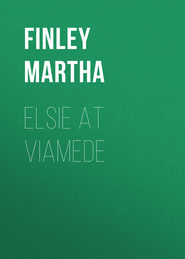По всем вопросам обращайтесь на: info@litportal.ru
(©) 2003-2024.
✖
Elsie at the World's Fair
Настройки чтения
Размер шрифта
Высота строк
Поля
Then Grandma Elsie expressed a desire to visit the building of her native State – Louisiana – and invited all in the party to go with her and dine there as her guests. All accepted the invitation with apparent pleasure and immediately turned their steps thitherward.
"Where is it?" someone asked, and Harold answered: "At the northern curve of the horseshoe formed by the State sites around the Fine Art Galleries and just west of the Missouri building. It is not a long walk."
"Ah," exclaimed Grandma Elsie when they caught sight of their destination, "see those trees in front laden with moss from our Southern bayous! The sight almost carries one back to the old days at Viamede."
"Yes; that and the foliage generally, which is of the tropical order," remarked her father in reply; "see, the cacti are conspicuous. And I like the simple style of the building with its galleries and verandas."
"And the site is a fine one," remarked the captain, "not far from the cable car entrance and fronting the Art Palace."
"Shall we dine first and then look at the exhibits?" asked Grandma Elsie. "I want to give you all a real Southern dinner, hoping it may prove agreeable to your palates."
"I presume we can stand it for once, mother dear," returned Herbert, and the rest of the party seemed equally willing.
They passed in and were presently regaling themselves with gumbo soup, opossum, and various other dishes peculiar to the part of the country represented by the building and its appurtenances, being served by cooks and waiters directly from the plantations of the river country.
Then, having satisfied their appetites, they spent some time in examining the relics on exhibit in the building.
One of these was a picture of the Madonna by Raphael. There was also an exhibition of carvings done by women, which excited both admiration and surprise, and in one of the rooms was some richly carved furniture from the State museum at Baton Rouge, which had once belonged to Governor Galvez.
They went next to the Florida building, which was a reproduction of old Fort Marion, whose foundations were laid in 1620, the year of the landing of the Pilgrims in Massachusetts.
The captain mentioned that fact, then asked: "Do you know, Grace, how long that fort was in building?"
"No, papa," she replied, "can you tell us?"
"It took one hundred and fifty years of toil by exiles, convicts, and slaves to construct the heavy walls, curtains, bastions, and towers of defence. Its bloodiest days were more than a century before our Civil War, in which it did not take a very prominent part."
"Where are the curtains, papa?" asked little Elsie. "I don't see any."
"It is the name given to that part of the rampart which connects the flanks of two bastions," replied her father.
"And it was here that the Apaches were imprisoned," remarked Walter.
"Yes," returned his mother, "and a most gloomy prison it must have proved to them, used as they were to the free life of the mountains, prairies, and forests."
Some little time longer was spent in viewing the tropical plants and trees that adorned the exterior of the fort, then they passed inside and examined the many beautiful things to be seen there.
Their next visit was to the headquarters of the State of Washington, where they were much interested in the display of her native woods and the rockery built of native ores, showing pure streaks of gold and silver, so illustrating the mineral wealth of the State.
"Where next?" asked Mr. Dinsmore as they passed out.
"Papa, I'm so tired," little Elsie was saying at the same moment, in a low aside to her father.
"I, too," added Ned, overhearing her. "Please can't we take a ride now?"
"Surely," said Grandpa Dinsmore, overhearing the request. "I invite you all to try an electric boat on the lagoon."
No one seemed disposed to decline the invitation; some time was spent on the water, then on the Intramural Railway. After that the whole party, at the invitation of Violet and the captain, went aboard the yacht, still lying in the lake at no great distance from the Peristyle, and partook of a supper which was no unpleasant contrast to the enjoyable dinner with which Grandma Elsie had provided them.
The little folks were ready for bed, on leaving the table; the older ones rested for a time on the Dolphin's deck, chatting together while enjoying the sunset, then they returned to the Court of Honor, to revel in its beauties as seen by the witchery of the electric light.
CHAPTER VI
Morning found them all rested, refreshed, and eager to spend another day amid the beauties of the Fair. They started early, as on the previous day, found Harold and Herbert with the other young gentlemen friends waiting for them in the Peristyle, spent a little time enjoying its beauties and the never wearying view it afforded of the lake on the one side, and the Court of Honor on the other, then at the earnest solicitation of the little ones they again entered an electric launch and glided swiftly along the quiet waters of the lagoon.
"Let us go to the Transportation Building," proposed Rosie as they landed again. "I want to see that golden doorway, and have not the least objection to passing through it and examining things inside."
"As no one else has, I presume," said her grandfather. "No doubt we shall find a great deal there worthy of examination."
"Yes, sir; much more than we can attend to in one visit," replied Harold, leading the way, as everyone seemed well pleased to carry out Rosie's suggestion.
They had heard and read of the beautiful golden doorway and viewed it with interest and satisfaction.
"It is very, very beautiful," said Grandma Elsie, "a nest of arches covered with silver and gold."
"And that border is lovely, lovely!" exclaimed Rosie; "such delicate tracery!"
"Papa, is it solid gold?" asked little Elsie, who was clinging to her father's hand on one side, while Ned had fast hold of the other.
"No, daughter," the captain replied, "not solid, though there is a good deal of both gold and silver covering the other and cheaper materials." Then he called her attention to a relief on the left side of the arch, showing an ox-cart with its clumsy wheels dragging slowly along through heavy sand, the travellers in it looking most uncomfortable.
"That, children," he said, "is the way people used to travel years ago when I was a little fellow, such as you are now, Neddie boy; and this" – going to the other side of the arch and pointing to the contrasting relief – "shows how we travel now. See, it is a section of a palace-car; some of the people reading, others gazing from its plate-glass windows, and a porter serving them with luncheon."
"Yes, papa; that's the way we travel when we don't go in the Dolphin or in our carriage, and it's a great deal nicer than that ox-cart," said Elsie.
"Oh, papa, there are some words up there!" exclaimed Ned, pointing up to a higher part of the arch. "Please read them."
"I will, son," replied the captain, "though I think you are hardly old enough to fully understand them. This" – pointing it out – "was written by Macaulay, of whom you will learn more when you are older: 'Of all inventions, the alphabet and the printing-press alone excepted, those inventions which abridge distance have done the most for civilization.' This other is by Lord Bacon: 'There are three things which make a nation great and prosperous: a fertile soil, busy workshops, and easy conveyance for men and goods from place to place.' Those words are put upon this building because in it are shown the different modes of travel in different countries – on the sea also – at different times."
They stood for some little time longer examining into the details of that wondrously beautiful doorway, noticing the splendor of the arches and pylon, the stairway on each side, the roof of the pavilion and all the other beauties.
"It is very beautiful, and a great satisfaction to have seen it," remarked Mr. Dinsmore at length, "but perhaps it would be as well for us to go on into the inside of the building now, reserving further examination of this golden doorway for some future time."
With that he passed in, the others following.
Many of the exhibits there were more interesting to the older members of the party, especially the gentlemen, than to the ladies and younger people; locomotives and trains of cars such as were in use at different periods of time, showing the vast improvement in their construction since steam was first put to that use, models of vessels teaching the same lesson in regard to increased convenience and comfort of travel upon the water.
"Oh, there is the Victoria– that grandest of battleships, sunk only the other day in collision with her sister ship, the Camperdown!" exclaimed Herbert. "See what a crowd of men and women are gazing upon it!"
"Oh, yes," said Rosie, "I remember reading a description of it in the papers. One of England's finest battleships, was she not?"
"Yes," said Captain Raymond, drawing near and examining the model with interest; "she was a grand vessel, the pride of the British navy. I should like to have seen her and am glad to have the opportunity to examine even a model. Ah, what a sad accident it was! especially considering that it sent to the bottom of the sea her entire crew of nearly four hundred men and officers."
"Oh, it was dreadful, dreadful!" said Grace in tearful tones. "Especially because they had no time to think and prepare for death."
"Yes, that is the saddest part of all," sighed Grandma Elsie.
Our friends presently moved on, and all, from Grandpa Dinsmore down to little Ned, found many objects that interested them greatly. But the most attractive thing of all to the young folks – because of the story connected with it – was Grace Darling's boat. It was the captain who pointed it out to his children.











